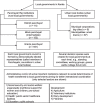Decentralisation, health and Sustainable Development Goal 3
- PMID: 36949743
- PMCID: PMC9983807
- DOI: 10.5588/pha.22.0034
Decentralisation, health and Sustainable Development Goal 3
Abstract
Setting: Kerala State, India, implemented decentralising reforms of healthcare institutions 25 years ago through transfer of administrative control and a sizeable share of the financial allocation.
Objective: To describe the main impacts of decentralisation in Kerala on local policy formulation, programme implementation and service delivery for sustainable health systems.
Design: This was part of a broader qualitative study on decentralisation and health in Kerala. We conducted 25 in-depth interviews and reviewed 31 government orders or policy documents, five related transcripts and five thematic reports from the main study.
Results: Liaising between health system and local governments has improved over time. A shift from welfare-centric projects to infrastructure, human resources and services was evident. Considerable heterogeneity existed due to varying degrees of involvement, capacity, resources and needs of the community. State-level discourse and recent augmentation efforts for moving towards the UN Sustainable Development Goals (SDGs) strongly uphold the role of local governments in planning, financing and implementation.
Conclusion: The 25-year history of decentralised healthcare administration in Kerala indicates both successes and failures. Central support without disempowering the local governments can be a viable option to allow flexible decision-making consistent with broader system goals.
Contexte: L’État du Kerala, en Inde, a mis en œuvre des réformes de décentralisation des établissements de santé il y a 25 ans, en transférant le contrôle administratif et une part importante de l’allocation financière.
Objectif: Décrire les principaux impacts de la décentralisation au Kerala sur la formulation de politiques locales, la mise en œuvre de programmes et la prestation de services pour des systèmes de santé durables.
Méthode: Cette étude faisait partie d’une étude qualitative plus vaste sur la décentralisation et la santé au Kerala. Nous avons mené 25 entretiens approfondis et examiné 31 décrets ou documents de politique du gouvernement, cinq transcriptions connexes et cinq rapports thématiques de l’étude principale.
Résultats: La liaison entre le système de santé et les gouvernements locaux s’est améliorée au fil du temps. Une réorientation des projets centrés sur le bien-être vers les infrastructures, les ressources humaines et les services était évidente. Une hétérogénéité considérable existe en raison des différents degrés d’implication, de capacité, de ressources et de besoins de la communauté. Le discours au niveau de l’État et les récents efforts d’augmentation en vue d’atteindre les objectifs de développement durable (SDG) de l’ONU soutiennent fortement le rôle des gouvernements locaux dans la planification, le financement et la mise en œuvre.
Conclusion: Les 25 ans d’histoire de l’administration décentralisée des soins de santé au Kerala révèlent à la fois des réussites et des échecs. Un soutien central sans déresponsabiliser les gouvernements locaux peut être une option viable pour permettre une prise de décision flexible et cohérente avec les objectifs plus larges du système.
Keywords: India; Kerala; SDG3; central augmentation; health systems; local governments; qualitative study.
© 2023 The Union.
Conflict of interest statement
Conflicts of interest: none declared.
Figures
References
-
- Veron R. The “new” Kerala model: lessons for sustainable development. World Development. 2001;29(4):601–617.
-
- Franke RW, Chasin BH. Kerala State, India: radical reform as development. Int J Health Serv. 1992;22(1):139–156. - PubMed
-
- Mencher JP. The lessons and non-lessons of Kerala: agricultural labourers and poverty. Economic and political weekly. 1980;15(41–43):1781–1802.
-
- Kutty VR. Historical analysis of the development of healthcare facilities in Kerala State, India. Health Policy Plan. 2000;15(1):103–109. - PubMed
-
- Elamon J, Franke RW, Ekbal B. Decentralization of health services: the Kerala People’s Campaign. Int J Health Serv. 2004;34(4):681–708. - PubMed
LinkOut - more resources
Full Text Sources


